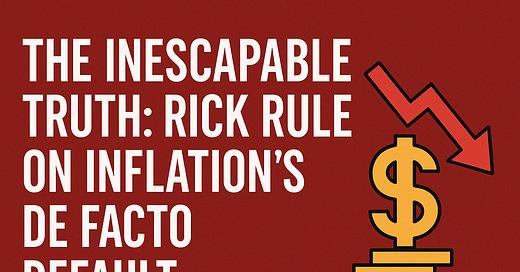The Inescapable Truth: Rick Rule on Inflation's De Facto Default
How Unchecked Inflation and Unfunded Entitlements Are Silently Eroding Your Wealth and What You Can Do to Fight Back
Introduction: A Storm of Debt and Diminishing Returns
In a world flooded with cheap credit, rising interest rates, and unchecked government spending, few voices cut through the noise like Rick Rule. With over four decades of experience in resource investing and a storied tenure as CEO of Sprott Asset Management, Rule is both a historian of markets and a realist about the road ahead. His latest interview with Liberty and Finance host Kaiser Johnson offers a sobering but deeply insightful view into the economic forces reshaping our financial future, and what individuals can do to survive them.
At the core of Rule’s argument is this: governments will not save you from financial ruin. Inflation is not a bug, it is a feature. And those who want to preserve their wealth must rely on arithmetic, not ideology.
Interest Rates: The Market Reclaims Control
“The market seems to be controlling the long end of the yield curve rather than the politicians,” Rule warns. For decades, the Federal Reserve has attempted to manipulate interest rates through buying and selling bonds, but according to Rule, that game is over. While central banks may still suppress the short end of the curve, the long end is now being dictated by market confidence or lack thereof.
He notes the resurgence of what former President Clinton called the “bond vigilantes,” investors who demand higher yields when they sense fiscal irresponsibility. The return of these players signals the market's growing skepticism toward U.S. debt.
“If interest rates were left to the market, I wouldn’t buy a 10-year or a 30-year bond that didn’t have a yield that was 9.5% or 10%,” Rule says. This contrasts starkly with the current environment, where long-term yields hover around 5%, despite real inflation running much higher than the official 2.5% figure.
This loss of control over interest rates sets the stage for the broader consequences of inflation, which Rule sees as the inevitable outcome of a debt-addicted political class.
Inflation: The Inescapable Mathematical Truth
“They will inflate away the real value of the obligation while paying the nominal value,” Rule explains. This is not speculation, it is a practiced strategy. Rather than face the political fallout of defaulting on Social Security or Medicare, governments simply debase the currency in which these promises are paid.
Drawing on historical precedent, Rule points to the 1970s, when the U.S. dollar lost 75% of its purchasing power in a single decade. Retirees received the same nominal payments but could buy far less with them.
He puts this into clear terms: “That $4,000 a month will buy $1,000 in goods and services.” For savers and retirees, the message is stark. Nominal figures are illusions unless backed by purchasing power.
Inflation, then, is not merely a cost of doing business. It is the mechanism by which governments resolve unpayable obligations. For investors, this means that real returns matter more than nominal yields, and assets that preserve purchasing power, like gold, become essential.
Unsustainable Debt: Arithmetic Doesn’t Care About Politics
Rule systematically dismantles the illusion that the U.S. can grow or tax its way out of debt. The numbers speak for themselves. A $36 trillion on-balance-sheet federal debt, plus $100 trillion in off-balance-sheet liabilities like Social Security and Medicare, against $141 trillion in aggregate private net worth. That leaves just $5 trillion in cushion, and it shrinks by $4 trillion annually.
“The billionaires have an aggregate net worth of $6.7 trillion,” he notes. “If you stole all their money, you would fund the federal government for less than two years.”
While politicians may posture about soaking the rich or increasing eligibility requirements, Rule is clear: “Playing around the edges does not matter arithmetically.” Inflation is not a policy choice, it is a mathematical necessity.
For ordinary people, this has profound implications. Retirement plans based on fixed-income assumptions could be gutted by invisible currency depreciation, and the mirage of safety in government bonds may soon fade.
The Architects of Global Crisis
Trade wars erupt. Insider fortunes swell amidst public turmoil. Debt becomes a weapon. Digital chains tighten. The headlines scream of chaos, but Nicolás Morás, in a sweeping and unflinching exposé, invites us to look beyond the surface. Step backstage, he urges, away from the dazzling but deceptive performance orchestrated by a global elite. What awaits is not a world spiraling out of control, but a meticulously scripted collapse – a grand theater where every crisis is a scene, every policy a prop, designed to usher in a new global order built in their image, brick by digital brick. Prepare to see the stagehands, the hidden levers, and the ultimate, self-serving motives behind the unfolding drama.
Gold vs. Silver: Insurance and Speculation
Rule draws a sharp distinction between gold and silver, not just in price or volatility, but in purpose. “Gold is insurance. Silver is speculation,” he states flatly. Gold, in his view, is not for getting rich, it is for staying solvent.
“My experience has been that precious metals bull markets are led by gold,” Rule explains. Only once gold establishes momentum do generalist investors begin piling into silver, shifting the narrative.
While silver can generate outsized returns during bull runs, Rule cites past 10x moves, its volatility makes it unsuitable for those seeking stability. “I don’t need to get rich on silver. I need to maintain my purchasing power,” he quips.
This bifurcation of assets reflects Rule’s broader philosophy. Use gold to hedge against systemic failure, and silver only when you have the risk tolerance, time horizon, and insight to speculate wisely.
The Dollar Won’t Collapse, But It Will Crumble
“The dollar didn’t go to zero in the 1970s, but it did lose 75% of its purchasing power,” Rule reminds us. He scoffs at doomsday predictions of total collapse, instead describing a more insidious erosion of value over time.
He likens the U.S. dollar to “the prettiest mare at the slaughterhouse,” still the strongest fiat currency, but that’s hardly a compliment in a field of declining contenders.
To illustrate the dollar’s decay, Rule recalls that the 1970 minimum wage, five silver quarters, would today be worth $21 to $22. Those coins held their value. The dollar did not.
This slow-motion wealth transfer from savers to debtors is the unspoken cost of inflation. Rule advises keeping maturities short, one to three years, and holding U.S. dollars only for immediate liquidity needs.
Risk Perception: Focus on What You Can Control
Rule addresses fears around asset confiscation, like the so-called “Great Taking,” with characteristic bluntness. “Your greatest financial risk is conveniently located to the left of your right ear and to the right of your left ear.”
Rather than fret about improbable scenarios, he urges investors to master the basics: live below your means, build savings, and invest in what you understand.
This approach also explains his skepticism toward complex derivatives like CFDs and options. Rule has consistently dismissed them as “arithmetically and probabilistically poor trades.” Most expire worthless, and they often encourage speculation over prudence. “I’m a plodder,” he says, noting that only geniuses, or those who mistake themselves for one, should dabble in such instruments.
His point is simple. Sovereignty does not begin with blaming the government. It begins with personal discipline.
Mining Stocks: Discipline Over Drama
Silver equities, Rule explains, offer explosive upside but also brutal volatility. “A portfolio of penny dreadfuls over time will go to zero,” he cautions. For most investors, the safer strategy is to buy the highest quality producers, the majors.
“If we have a silver equities bull market, and I believe we will, the majors will give you four or five or sixfold returns with very little operational risk,” he says.
While Rule himself owns a handful of ultra-speculative juniors because he “doesn’t have a life,” he advises average investors to avoid them unless they’re willing to do immense due diligence, including learning about “local politics in Guatemala or Mexico.”
The key, he says, isn’t just knowing when to buy. It’s knowing when to sell, because “to make the money, you must take the money.”
Conclusion: Arithmetic Over Ideology
“It’s just simple arithmetic.”
Rick Rule does not sell fear. He sells clarity. His message is as rigorous as it is unflinching. Inflation is not a policy flaw, it is a mathematical solution to unsustainable promises. The antidote is not political hope or financial engineering. It is personal prudence.
In a time of fiscal illusion, Rule’s truth may be inconvenient, but it is one you can count on.
Ask yourself, in a system built on promises, what assets do you hold that can’t be inflated away?











